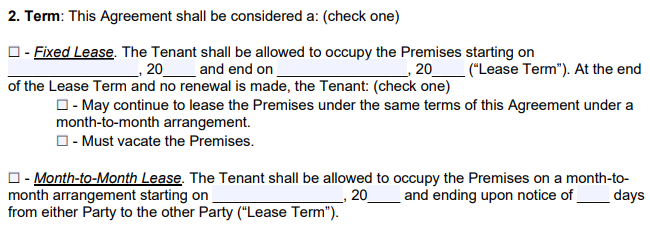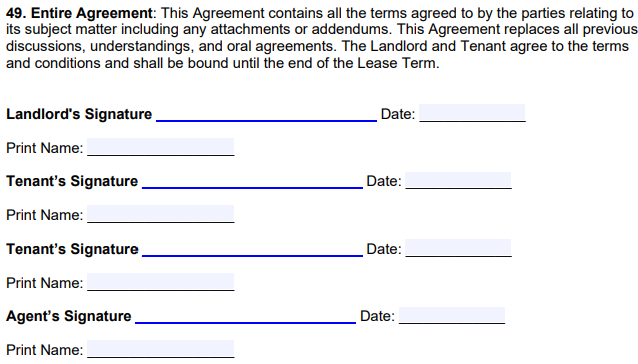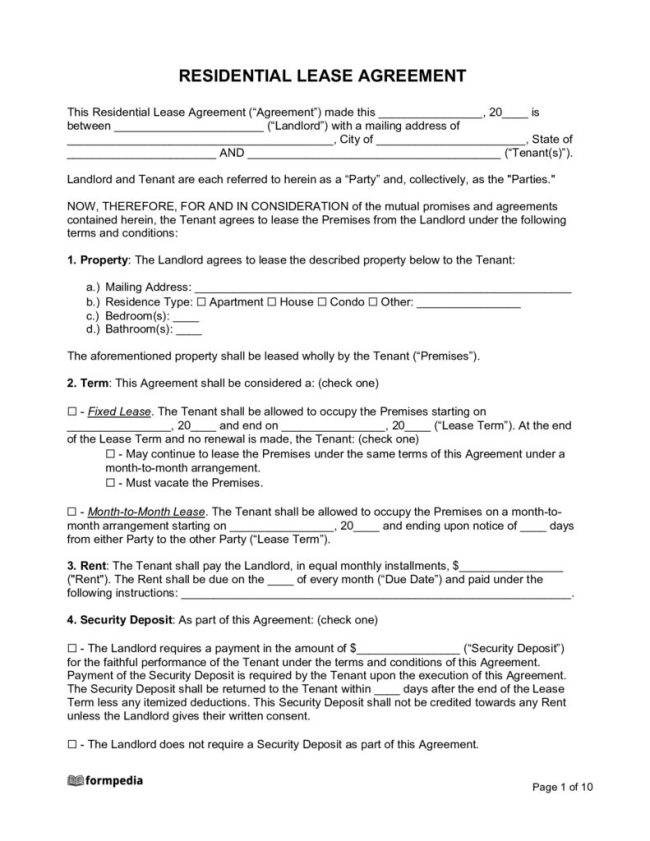A rental lease agreement is a critical document established between a property owner and an individual wishing to rent the property. This could be a residential home or a commercial space. This document unambiguously lays out the duties and rights of both parties during the agreement period.
When the document is signed, it’s standard for the renter to pay for the first month’s rent and also provide a security deposit. The renter can begin utilizing the property from the start date specified in the document, not from the date they signed the agreement.
By State
- Alabama
- Alaska
- Arizona
- Arkansas
- California
- Colorado
- Connecticut
- Delaware
- Florida
- Georgia
- Hawaii
- Idaho
- Illinois
- Indiana
- Iowa
- Kansas
- Kentucky
- Louisiana
- Maine
- Maryland
- Massachusetts
- Michigan
- Minnesota
- Mississippi
- Missouri
- Montana
- Nebraska
- Nevada
- New Hampshire
- New Jersey
- New Mexico
- New York
- North Carolina
- North Dakota
- Ohio
- Oklahoma
- Oregon
- Pennsylvania
- Rhode Island
- South Carolina
- South Dakota
- Tennessee
- Texas
- Utah
- Vermont
- Virginia
- Washington
- West Virginia
- Wisconsin
- Wyoming
Types of Rental Lease Agreements (8)
Commercial Lease Agreement – This is for non-residential uses like retail, office, or industrial spaces.
Condominium Lease Agreement – This is for a living unit that’s part of a condo association.
Month-to-Month Rental Agreement – Also known as “tenancy at will,” this arrangement goes on until the landlord or the tenant sends a notice to end it (usually 30 days in advance).
Roommate Agreement – This sets up money-related and social rules for tenants sharing the same flat or house.
Standard Residential Lease Agreement – This is the most common type of agreement. It’s a set-period contract for renting a property for several months to a year or more.
Sublease Agreement – This lets a tenant who has a lease to rent out (sublet) some or all of their rented space to another person.
Short Term / Vacation Lease Agreement – This is a simple rental deal for short stays.
Weekly (Week-to-week) Rental Agreement – This is an “at-will” deal that can be ended by giving a seven (7) days’ notice.
What Does Lease Mean?
Lease Implementation (10 Steps):
- Property Marketing/Discovery: Advertise the property online and in local classifieds.
- Arranging a Property Viewing: Schedule a viewing with interested parties. Use a rental application form to gather applicant information and consent for a credit and background check.
- Tenant Screening: Conduct credit and background checks and verify income and references.
- Approval or Rejection of the Tenant: Review the applicant’s credit report, criminal history, and references. Provide an adverse action letter if rejected.
- Negotiations: Negotiate lease terms. If the applicant has poor credit, consider increasing the security deposit or monthly rent, requesting rent prepayment, or requiring a co-signer.
- Lease Signing: Both parties sign the lease, preferably in the presence of a witness or notary public. Electronic signing is also an option.
- Occupancy Commencement: Collect payments (security deposit, first month’s rent) from the tenant and provide access to the property.
- Rental Payments: Collect monthly rent payments, ideally through online or automatic methods.
- Lease Renewal or Termination: At the lease end, decide whether to renew the lease or terminate it.
- Security Deposit Return: Return the deposit (minus any deductions for damages) in accordance with state laws at the end of the lease.
Avoid these Mistakes
- Not Conducting Regular Property Inspections: A common mistake is neglecting to inspect the property regularly. These inspections can help landlords identify potential issues before they turn into larger, more expensive repairs.
- Not Enforcing Lease Terms: Overlooking breaches of lease terms can lead to bigger problems down the line. Landlords should ensure that all lease terms are clearly understood and consistently enforced to maintain a well-managed property.
- Inadequate Communication: Poor communication between the landlord and tenant can lead to misunderstandings and conflicts. Effective and regular communication helps foster a good landlord-tenant relationship.
- Ignoring Maintenance Requests: Failing to respond to maintenance requests promptly not only leads to tenant dissatisfaction but could also result in further property damage.
- Not Reviewing Local Laws and Regulations: Every region has specific laws and regulations regarding leasing and tenant rights. Overlooking these can lead to legal complications, so landlords should ensure they are well-versed in the local regulations.
- Setting Incorrect Rental Prices: Landlords sometimes make the mistake of not properly evaluating the local market, leading to setting rental prices too high or too low. It’s essential to research local rental rates to ensure the property is competitively priced.
How to Write a Sample Lease Agreement
Step-by-step guide
1. Identify the Parties
State the full names of the landlord and the tenant(s).

2. Property Description
Describe the property being rented. This should include the property’s address and any specific unit number.

3. Lease Term
Specify the start and end dates of the lease. For month-to-month agreements, state that the lease will continue until either party terminates with proper notice.

4. Rent Details
Indicate the rent amount, due date, and payment method. Include details about late fees if applicable.

5. Security Deposit
State the amount of the security deposit, when and how it will be returned, and conditions under which part or all of it may be withheld.

6. Maintenance and Repairs
7. Rules and Regulations
8. Termination
9. Signatures
Both the landlord and tenant(s) should sign and date the agreement.

Sample
SAMPLE LEASE AGREEMENT
THIS LEASE AGREEMENT (“Lease”) made and entered into this ______ (date), by and between _______________________________________ (hereinafter “Landlord”), and ________________________ (hereinafter “Tenant(s)”).
- PREMISES: Landlord rents to Tenant and Tenant rents from Landlord, the premises located at ____________________________________. The premises will be used for residential purposes only.
- TERM: The initial term of this Lease will begin on ___________, and will end on ___________. Thereafter, the Lease will continue on a month-to-month basis until either Landlord or Tenant terminate this Lease with written notice.
- RENT: Tenant agrees to pay $______ per month, due on the 1st day of each calendar month.
- SECURITY DEPOSIT: Upon the due execution of this Agreement, Tenant will deposit with Landlord the sum of $_____ as security for any damage caused during the Lease term.
- MAINTENANCE AND REPAIRS: Tenant will keep the premises in clean, sanitary, and good condition.
- RULES AND REGULATIONS: Tenant agrees not to keep any pets without the Landlord’s written consent. The smoking of tobacco products is prohibited on the property.
- DEFAULT: If Tenant fails to comply with any of the material provisions of this Lease or of any present rules and regulations, Landlord may terminate this Lease upon providing proper notice to Tenant.
- TERMINATION: Upon termination of this Lease, Tenant will return the Premises and all property of Landlord in a clean and good condition.
The parties hereby bind themselves to this agreement by their signatures affixed below on this ________ day of ____________, 20.
LANDLORD:
TENANT:
Frequently Asked Questions
- What is a rental lease agreement?
- What should be included in a lease agreement?
- What happens if my landlord fails to maintain the property as per the lease agreement?
- What happens when a lease expires?
- Can a landlord enter my apartment whenever they want?
What is a rental lease agreement?
A rental lease agreement is a legally binding contract between a landlord and tenant that outlines the terms and conditions for renting a property. It includes information such as the length of the lease, monthly rent, and tenant and landlord responsibilities.
What should be included in a lease agreement?
A typical lease agreement includes details such as the names of the parties, description of the property, rent amount and payment terms, security deposit details, lease term, repair and maintenance responsibilities, rules about pets, and consequences for lease violations.
What happens if my landlord fails to maintain the property as per the lease agreement?
If a landlord fails to maintain a property in line with the agreement, such as not addressing repair issues, it could be seen as a breach of contract. Tenants may have legal rights to withhold rent or “repair and deduct”. However, the specific actions a tenant can take vary by local and state laws, so it’s essential to seek legal counsel.
What happens when a lease expires?
The course of action when a lease expires often depends on the terms of the lease and local law. Some leases automatically convert to a month-to-month agreement, others require the tenant to move out, and some may require a renewal of the lease for a new term. It’s important to read your lease to understand what happens upon its expiration.
Can a landlord enter my apartment whenever they want?
Generally, a landlord must provide reasonable notice, typically 24-48 hours, before entering a tenant’s unit, and the visit must be at a reasonable time. They can usually only enter for specific reasons, such as making repairs or showing the apartment to prospective tenants. The exact rules can vary by state, so you should check local laws for specifics.
